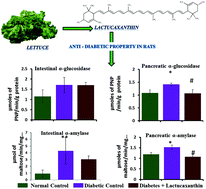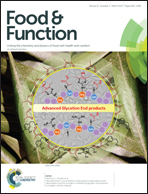Lactucaxanthin – a potential anti-diabetic carotenoid from lettuce (Lactuca sativa) inhibits α-amylase and α-glucosidase activity in vitro and in diabetic rats
Abstract
Intestinal and pancreatic α-amylase and α-glucosidase inhibitors offer an approach to lower the levels of post-prandial hyperglycemia through the control of dietary starch breakdown in digestion. This study hypothesized that lactucaxanthin (Lxn) in lettuce (Lactuca sativa) inhibits the activity of α-amylase and α-glucosidase. In this study, the interaction of Lxn with α-amylase and α-glucosidase in silico and its inhibitory effect on these enzymes were studied using in vitro and STZ-induced diabetic rat models. Lxn was isolated from lettuce with 96% purity confirmed by HPLC and LCMS. The in silico analysis showed that Lxn has a lower binding energy (−6.05 and −6.34 kcal mol−1) with α-amylase and α-glucosidase compared to their synthetic inhibitors, acarbose (−0.21 kcal mol−1) and miglitol (−2.78 kcal mol−1), respectively. In vitro α-amylase and α-glucosidase inhibition assays revealed that Lxn had IC50 values of 435.5 μg mL−1 and 1.84 mg mL−1, but acarbose has values of 2.5 and 16.19 μg mL−1. The in vivo results showed an increased activity for α-amylase and α-glucosidase in the intestine (4.7 and 1.30 fold, p < 0.05) and pancreas (1.3 and 1.48 fold, p < 0.05) of STZ induced diabetic rats compared to normal rats. Whereas the activity decreased (p < 0.05) in the Lxn fed diabetic rats, except for the intestinal α-glucosidase activity (1.69 ± 0.12 PNP per min per mg protein). This was confirmed by the low blood glucose level (239.4 ± 18.2 mg dL−1) in diabetic rats fed Lxn compared to the diabetic group (572.2 ± 30.5 mg dL−1, p < 0.05). Lxn significantly inhibited (p < 0.05) the activity of α-amylase and α-glucosidase and could be of medical and nutritional relevance in the treatment of diabetes.



 Please wait while we load your content...
Please wait while we load your content...